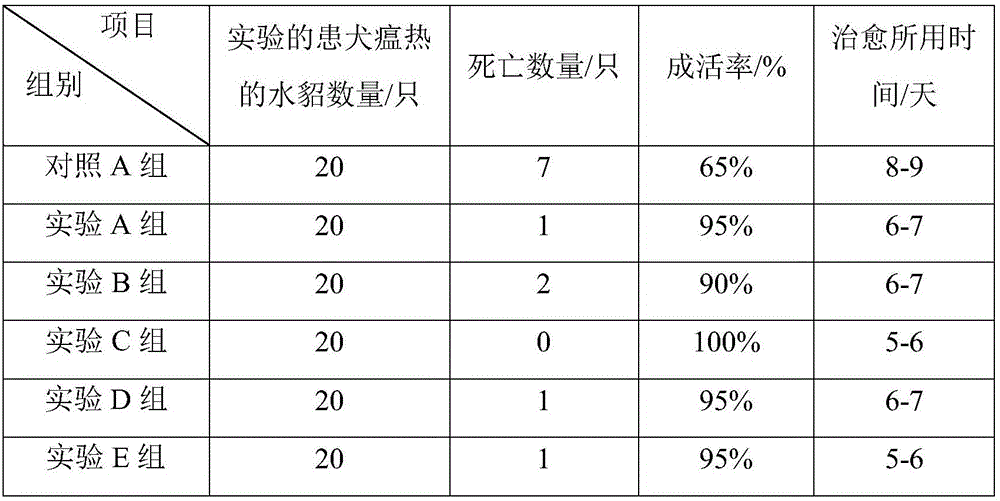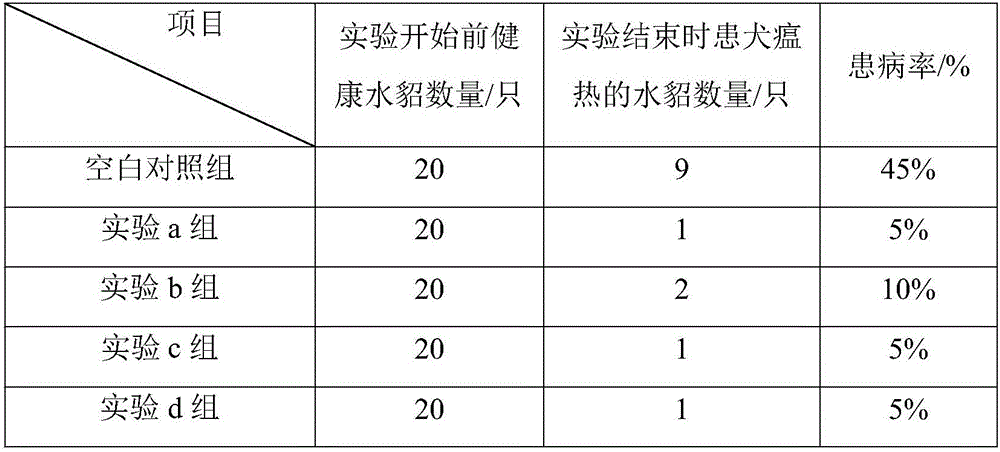Feed additive for treating mink distemper and preparation method thereof
A feed additive and canine distemper technology, applied in the field of feed additives, can solve the problems of poor curative effect, inability to completely cure canine distemper, and increased dosage
- Summary
- Abstract
- Description
- Claims
- Application Information
AI Technical Summary
Problems solved by technology
Method used
Image
Examples
Embodiment 1
[0032] A feed additive for treating canine distemper in mink, comprising the following components in parts by weight: 6 parts of pine needle powder, 6 parts of shrimp powder, 5 parts of rice bran, 5 parts of silkworm chrysalis, 3 parts of fish scale, 4 parts of chicken egg white, and Daqing 10 parts of leaves, 10 parts of geranium, 6 parts of gardenia, 9 parts of scrophulariaceae, 3 parts of soft-shelled turtle meat, 6 parts of angelica, 5 parts of tangerine peel, 6 parts of Atractylodes macrocephala, 5 parts of Qingtou fungus, 6 parts of schisandra, 5 parts of mulberry leaves 3 parts of winter melon seeds, 4 parts of Fritillaria, 3 parts of Baibu, 8 parts of fungus, 4 parts of pangolin, 4 parts of Angelica dahurica, 8 parts of Prunella vulgaris, 6 parts of Astragalus, 6 parts of Codonopsis, and 3 parts of olive oil.
[0033] The preparation method of the feed additive for the treatment of mink distemper comprises the following steps:
[0034] (1) After the fungus is washed an...
Embodiment 2
[0040] A feed additive for treating canine distemper in mink, comprising the following components in parts by weight: 12 parts of pine needle powder, 10 parts of shrimp powder, 15 parts of rice bran, 9 parts of silkworm chrysalis, 7 parts of fish scale, 8 parts of chicken white, and Daqing 20 parts of leaves, 20 parts of geranium, 12 parts of gardenia, 15 parts of scrophulariaceae, 7 parts of soft-shelled turtle meat, 10 parts of angelica, 10 parts of tangerine peel, 10 parts of Atractylodes macrocephala, 11 parts of Qingtou fungus, 10 parts of Wuweicao, 10 parts of mulberry leaves 5 parts of winter melon seeds, 10 parts of Fritillaria, 9 parts of Baibu, 16 parts of fungus, 8 parts of pangolin, 8 parts of Angelica dahurica, 12 parts of Prunella vulgaris, 12 parts of Astragalus, 12 parts of Dangshen, and 7 parts of olive oil.
[0041] The preparation method of the feed additive for the treatment of mink distemper comprises the following steps:
[0042] (1) After the fungus is w...
Embodiment 3
[0048] A feed additive for treating canine distemper in mink, comprising the following components in parts by weight: 9 parts of pine needle powder, 8 parts of shrimp powder, 10 parts of rice bran, 7 parts of silkworm chrysalis, 5 parts of fish scale, 6 parts of chicken white, and Daqing 15 parts of leaves, 15 parts of geranium, 9 parts of gardenia, 12 parts of scrophulariaceae, 5 parts of soft-shelled turtle meat, 8 parts of angelica, 8 parts of tangerine peel, 8 parts of Atractylodes macrocephala, 8 parts of Qingtou fungus, 8 parts of Wuweicao, 7 parts of mulberry leaves 4 parts of wax gourd seeds, 7 parts of Fritillaria, 6 parts of Baibu, 12 parts of fungus, 6 parts of pangolin, 6 parts of Angelica dahurica, 10 parts of Prunella vulgaris, 9 parts of Astragalus membranaceus, 9 parts of Codonopsis pilosula, 5 parts of olive oil.
[0049] The preparation method of the feed additive for the treatment of mink distemper comprises the following steps:
[0050] (1) After the fungus...
PUM
 Login to View More
Login to View More Abstract
Description
Claims
Application Information
 Login to View More
Login to View More - R&D
- Intellectual Property
- Life Sciences
- Materials
- Tech Scout
- Unparalleled Data Quality
- Higher Quality Content
- 60% Fewer Hallucinations
Browse by: Latest US Patents, China's latest patents, Technical Efficacy Thesaurus, Application Domain, Technology Topic, Popular Technical Reports.
© 2025 PatSnap. All rights reserved.Legal|Privacy policy|Modern Slavery Act Transparency Statement|Sitemap|About US| Contact US: help@patsnap.com


